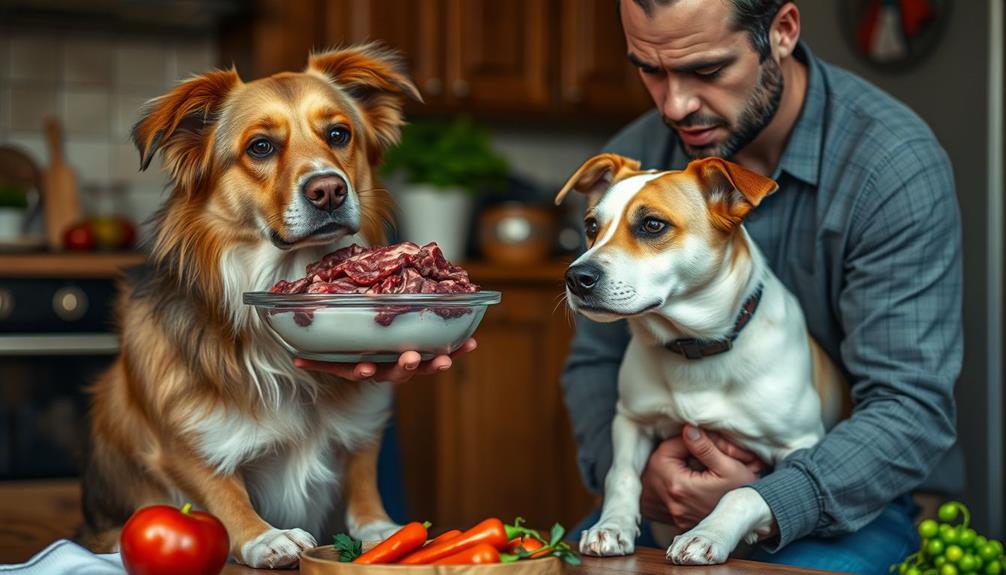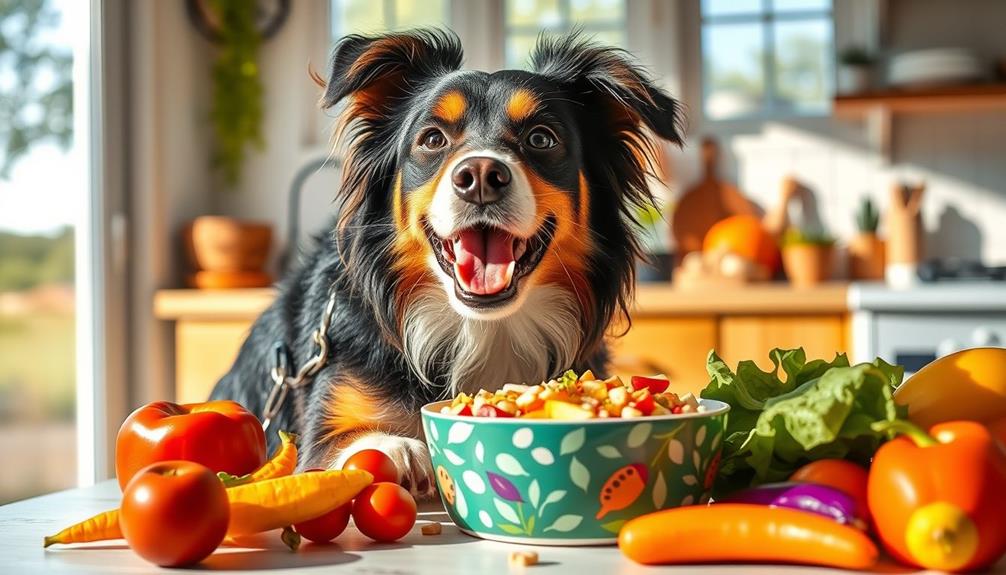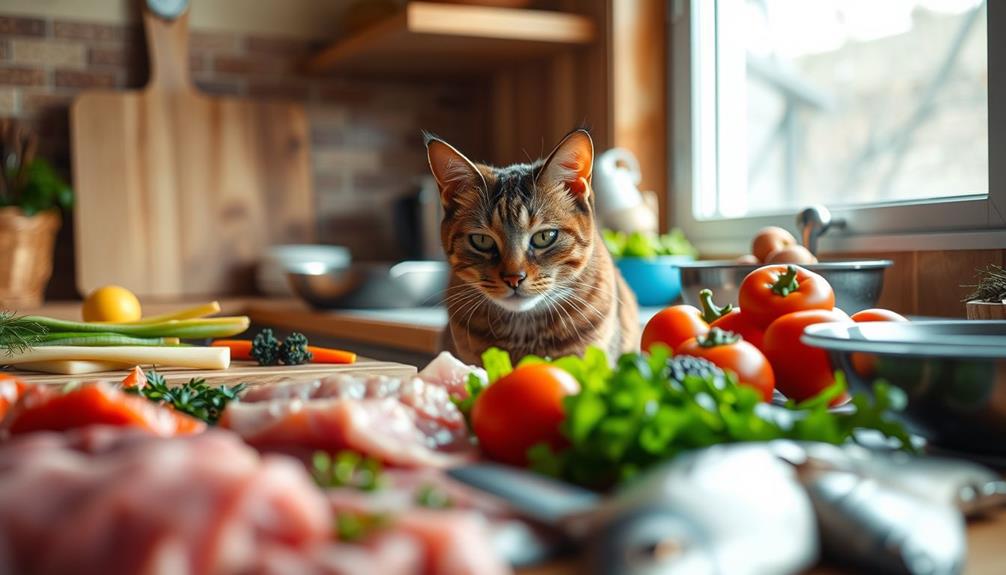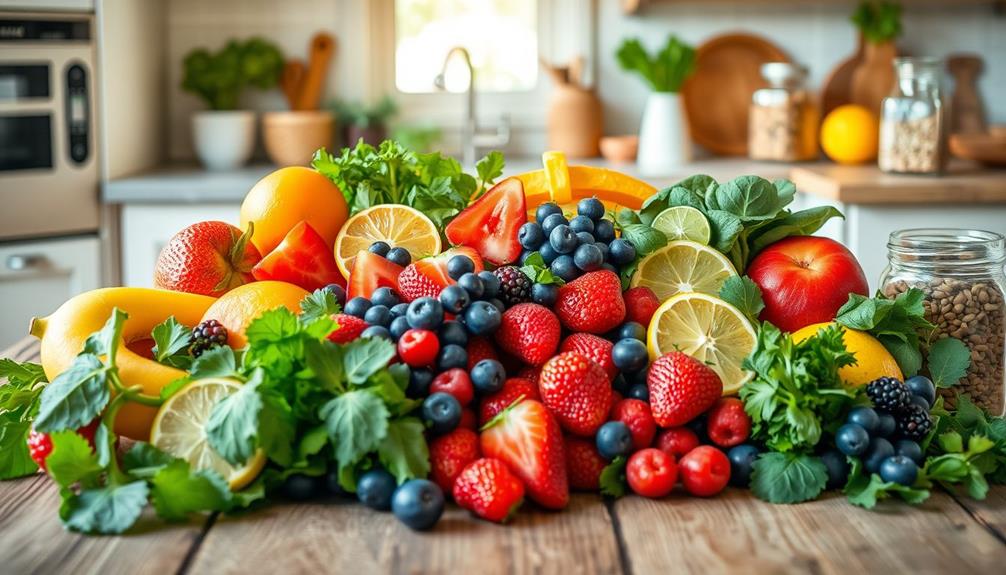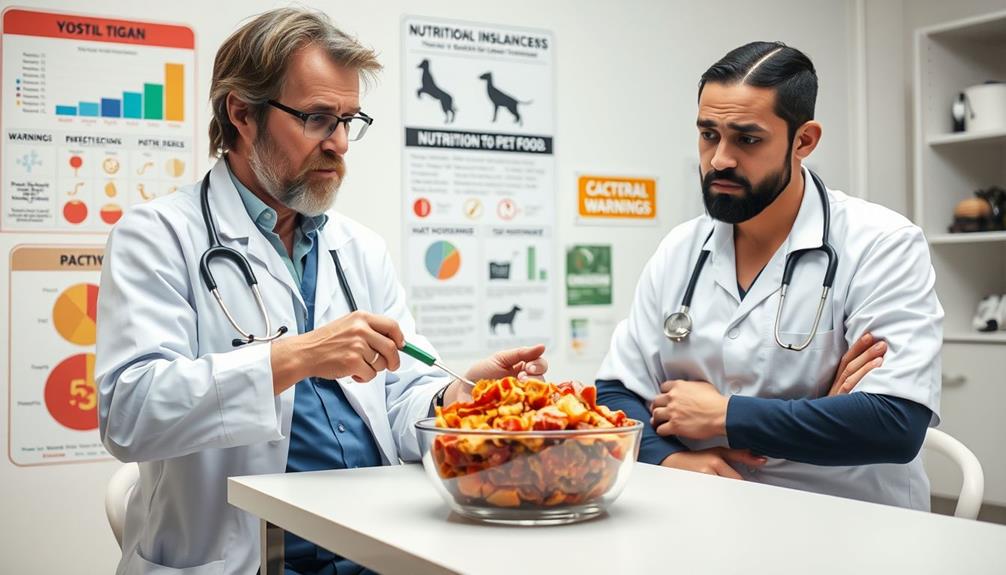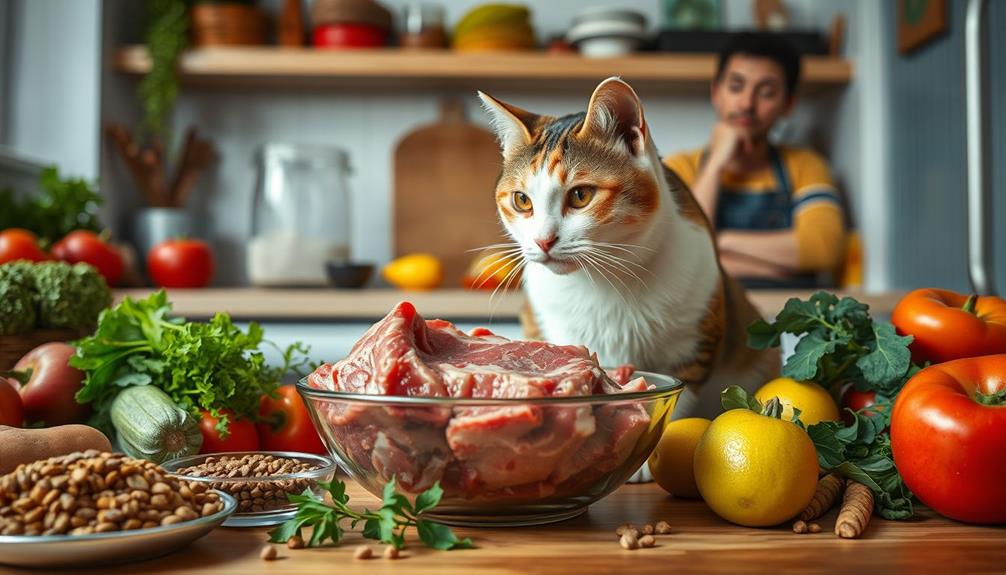Yes, raw food can upset your dog's stomach, particularly if you switch diets suddenly. Abrupt changes often lead to gastrointestinal issues like vomiting or diarrhea. If the diet isn't balanced, your dog might also face nutritional deficiencies, especially in essential vitamins, calcium, and phosphorus. Furthermore, raw meat can carry harmful bacteria like Salmonella and Listeria, posing risks to both your dog and your household. To minimize these risks, it's essential to shift gradually over about ten days. To understand how to make this shift safely and what to monitor, you'll find more useful insights ahead.
Key Takeaways
- Abruptly switching to raw food can cause gastrointestinal upset, leading to vomiting or diarrhea in dogs.
- Nutritional deficiencies may occur without a balanced raw diet, impacting overall health.
- Improper calcium-to-phosphorus ratios in raw diets can adversely affect puppies' bone development.
- About 25% of raw dog food samples are contaminated with harmful bacteria like Salmonella, posing health risks.
- Gradually transitioning to raw food over 7 to 10 days helps minimize digestive issues in dogs.
Understanding Raw Dog Food
Understanding raw dog food is fundamental for any pet owner considering this diet for their canine companion. Raw dog food typically includes raw meat, bones, fruits, and vegetables, aiming to mimic the evolutionary diet of dogs.
While many pet owners are shifting to a raw diet, feeding raw food can come with certain challenges. An abrupt switch might lead to gastrointestinal upset, as dogs require time to adjust to the new food source. It's essential to acknowledge that similar to hamsters, dogs also need a well-rounded diet to avoid nutritional deficiencies and health complications proper diet considerations.
It's vital to guarantee a balanced nutrient intake when feeding raw food. Nutritional deficiencies can arise if you don't provide a well-rounded diet, potentially affecting your dog's health.
Additionally, handling raw meat properly is significant, as improper practices may lead to bacterial contamination, posing serious health risks to your pet. You should always prioritize hygiene when preparing raw dog food to minimize these risks.
Pay attention to how your dog reacts during the shift, and consult a veterinarian if any issues arise. By understanding the components and challenges of raw dog food, you can make informed decisions to support your furry friend's well-being.
Benefits of Raw Diets

Adopting a raw diet for your dog can offer numerous benefits that enhance their overall health and energy. Raw diets are believed to align with your dog's ancestral eating habits, which may lead to improved energy levels and healthier body conditions. Many pet owners report noticeable changes in their dogs when switching to raw meat-based diets (RMBDs).
Additionally, incorporating a balanced diet rich in nutrients is essential for maintaining overall health, similar to the principles of sustainable weight loss.
One of the key advantages of raw diets is their high protein content, which helps maintain a healthy weight. Additionally, RMBDs often provide higher nutritional quality compared to processed foods, contributing to better immune system functionality.
Many dogs on these diets also experience improved skin health and shinier coats, thanks to the rich nutrients found in raw ingredients.
For dogs with food allergies, limited ingredient diets within the raw feeding framework can be particularly beneficial. These diets can help alleviate symptoms such as vomiting, diarrhea, and skin irritations, resulting in a happier, healthier pet.
Health Risks for Dogs
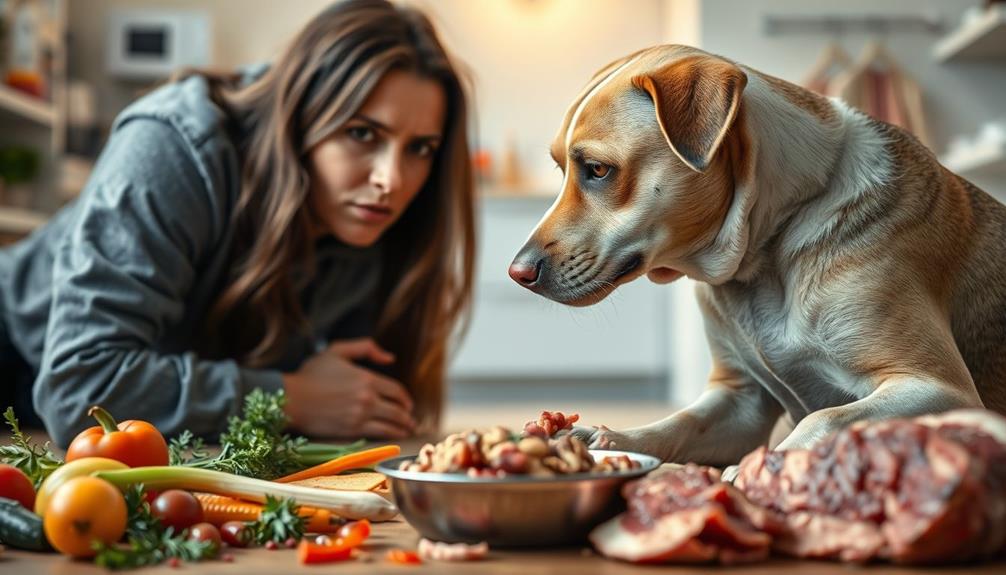
Shifting your dog to a raw diet might seem beneficial, but it can come with significant health risks. Changing too quickly from processed food to raw food can lead to gastrointestinal upset, causing symptoms like vomiting or diarrhea. This abrupt change disrupts your dog's digestive system, resulting in even more discomfort.
Additionally, it's essential to be aware of the potential common types of cold medications that might help alleviate any health issues your dog is facing during this change.
Moreover, raw diets can sometimes be unbalanced, lacking essential nutrients your dog needs for overall health. Over time, these deficiencies can lead to severe health issues, including ongoing gastrointestinal distress.
Puppies, in particular, are vulnerable to dietary changes; improper calcium-phosphorus ratios in raw diets can result in bone deformities and other complications.
There's also the concern of harmful bacteria. Studies show about 25% of raw food samples test positive for pathogens like Salmonella and Listeria, which pose risks not only to your dog but also to your family.
Bacterial Contamination Concerns

Bacterial contamination poses a serious threat when it comes to raw food diets for dogs. According to FDA studies, nearly 25% of raw food samples tested positive for harmful bacteria like Salmonella and Listeria monocytogenes. These pathogens can lead to severe food-borne illnesses in dogs and even pose health risks to humans.
Additionally, understanding common financial terms can help pet owners make informed decisions about budgeting for their pets' diets.
Here are three key concerns to keep in mind:
- Salmonella: This bacteria can cause gastrointestinal upset in your dog, leading to symptoms such as vomiting, diarrhea, fever, and lethargy. It can also be transmitted to humans, creating additional health risks.
- Listeria monocytogenes: Known for its ability to survive in various environments, Listeria poses a significant threat, especially to vulnerable populations like pregnant women and the elderly.
- Public health risks: The CDC and FDA have issued warnings about the dangers of handling raw pet food, highlighting the importance of sanitation to prevent cross-contamination.
To minimize these risks, always practice safe food handling techniques, including thorough handwashing and cleaning surfaces after handling raw food.
Transitioning to Raw Diets
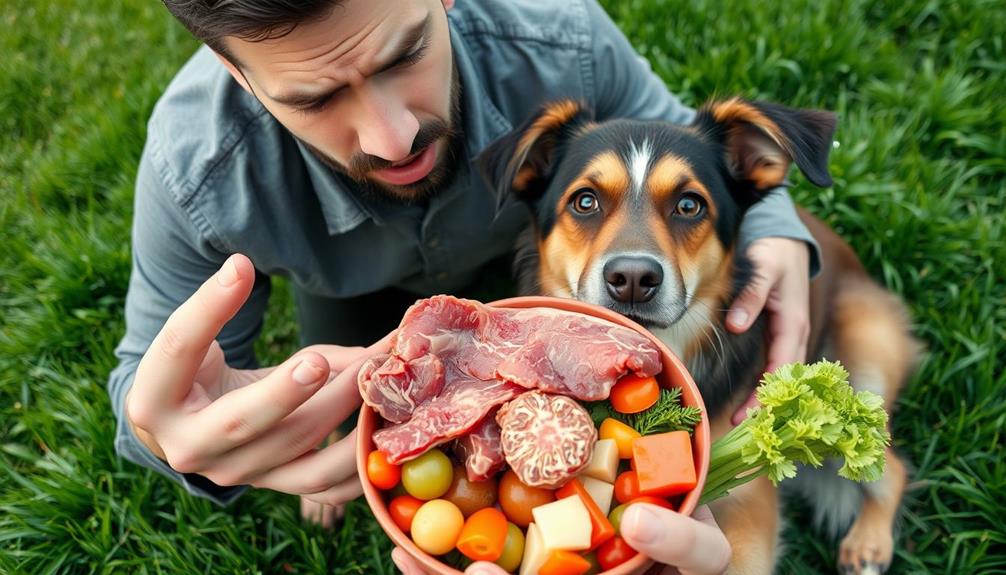
If you've decided to switch your dog to a raw food diet, it's important to understand how this change can affect their digestive system. A sudden shift can lead to gastrointestinal upset, causing symptoms like vomiting or diarrhea. To minimize these digestive disturbances, you should gradually introduce raw food over 7 to 10 days.
Here's a simple guide to help you shift:
| Day | Action |
|---|---|
| Days 1-3 | Mix 25% raw food with 75% current diet |
| Days 4-6 | Mix 50% raw food with 50% current diet |
| Days 7-9 | Mix 75% raw food with 25% current diet |
| Day 10 | 100% raw food |
Puppies and dogs with sensitive stomachs or pre-existing health conditions may be especially vulnerable to issues during this shift. It's vital to guarantee a balanced raw diet, paying attention to the calcium-phosphorus ratio to avoid further health problems. Consulting with a veterinary nutritionist can provide personalized guidance, helping you navigate the nuances of switching to raw diets while keeping your dog's stomach healthy.
Safety Precautions for Owners
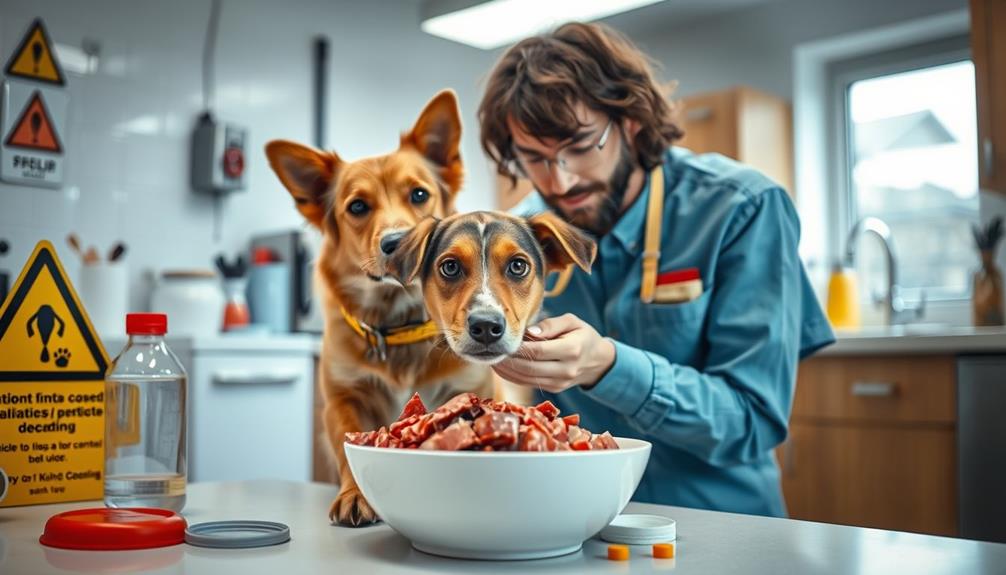
When you handle raw dog food, it's vital to follow proper meat handling practices to reduce the risk of harmful bacteria.
Just like how butter storage and freshness is essential to prevent spoilage, making certain that raw dog food is stored safely can help maintain its quality.
Make sure to store the food safely and maintain hygiene in your kitchen to protect both you and your pet.
Proper Meat Handling
Handling raw meat for your dog's diet requires strict safety precautions to protect both you and your pet. When you handle raw meat, you risk exposing yourself and your dog to harmful bacteria like Salmonella and Listeria monocytogenes. To guarantee health and safety, follow these guidelines:
1. Wash Your Hands: Always thoroughly wash your hands with soap for at least 20 seconds after handling raw meat. This helps prevent the spread of bacteria.
Implementing good hygiene practices is essential in maintaining a safe environment for both you and your dog, as highlighted in best practices in software quality assurance.
2. Disinfect Surfaces: After preparing your dog's food, disinfect all surfaces and utensils that came into contact with the raw meat. This minimizes the risk of cross-contamination with other food items.
3. Proper Thawing Methods: Store raw meat in the freezer until you're ready to use it. When thawing, use the refrigerator or microwave instead of room temperature to limit bacterial growth.
Avoid rinsing raw meat, as this can cause splash contamination.
Also, immediately refrigerate any uneaten raw pet food or dispose of it safely to prevent bacterial proliferation.
Safe Storage Practices
Storing raw dog food safely is essential to preventing bacterial growth and guaranteeing your pet's health. Start by keeping raw pet food frozen until you're ready to use it. This helps maintain safe temperatures and keeps harmful bacteria in raw food at bay.
When it's time to feed your dog, always thaw raw food in the refrigerator or microwave. Avoid thawing at room temperature, as this increases the risk of pathogens proliferating. Additionally, guarantee that the area around your dog's feeding station is clean and free from dust, which can also harbor bacteria and allergens, just like maintaining good air purifier maintenance.
To minimize cross-contamination, use separate storage containers for raw pet food and human food. This precaution is critical to keeping your family safe from any bacteria in raw dog food.
After handling raw food, make sure to disinfect surfaces, utensils, and dishes to eliminate harmful bacteria and maintain a clean environment.
If your dog doesn't finish their meal, refrigerate any uneaten raw pet food immediately or dispose of it safely. This practice prevents spoilage and further bacterial contamination.
Hygiene and Sanitation
Maintaining proper hygiene and sanitation practices is essential for dog owners who feed their pets raw food. By doing so, you can greatly reduce the risk of foodborne illness caused by disease-causing bacteria like Salmonella and Listeria monocytogenes.
Additionally, using essential oils like eucalyptus oil can help maintain a clean environment since they possess antimicrobial properties. Here are some key steps to follow:
- Wash your hands: Always wash your hands for at least 20 seconds with soap after handling raw dog food. This simple act can prevent the spread of harmful bacteria.
- Disinfect all surfaces: Clean and disinfect any surfaces, utensils, and objects that come in contact with raw dog food. This minimizes the risk of cross-contamination and protects your family from potential illnesses.
- Store and handle properly: Keep raw meat frozen until you're ready to use it. Thaw it in the refrigerator or microwave, and never rinse raw meat, as this can lead to splash contamination.
Additionally, remember to refrigerate any uneaten raw pet food immediately or dispose of it safely.
Nutritional Balance Challenges
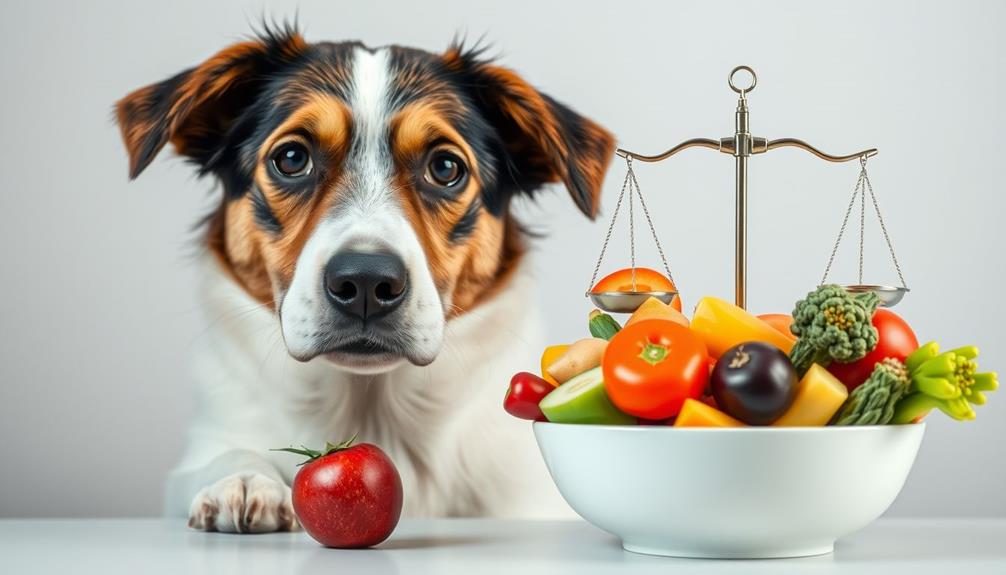
Balancing nutrition in a raw meat-based diet (RMBD) for your dog can be a tricky endeavor. While many pet owners are drawn to the raw food diet for its perceived benefits, it's important to guarantee complete nutrition.
Understanding the potential financial considerations for elderly care can be equally complex, especially when managing pet care costs. Homemade raw diets often lead to nutritional deficiencies, particularly in calcium and phosphorus, which are essential for your dog's health. Without proper balance, your pup may face serious health issues over time, including digestive disturbances.
Transitioning your dog to a raw diet too quickly can also cause gastrointestinal upset. This sudden change in food type can result in symptoms like vomiting or diarrhea, which can be distressing for both you and your dog.
Nutritional imbalances in RMBDs can further exacerbate these issues, as they may not provide all the necessary nutrients without careful supplementation.
As you consider a raw food diet, it's crucial to do thorough research and possibly consult a veterinarian. Ongoing studies aim to clarify the long-term health impacts of RMBDs, especially regarding nutritional balance and gut health.
Guaranteeing your dog receives adequate nutrition is paramount to preventing potential health risks associated with raw diets.
Veterinary Perspectives on Raw Diets
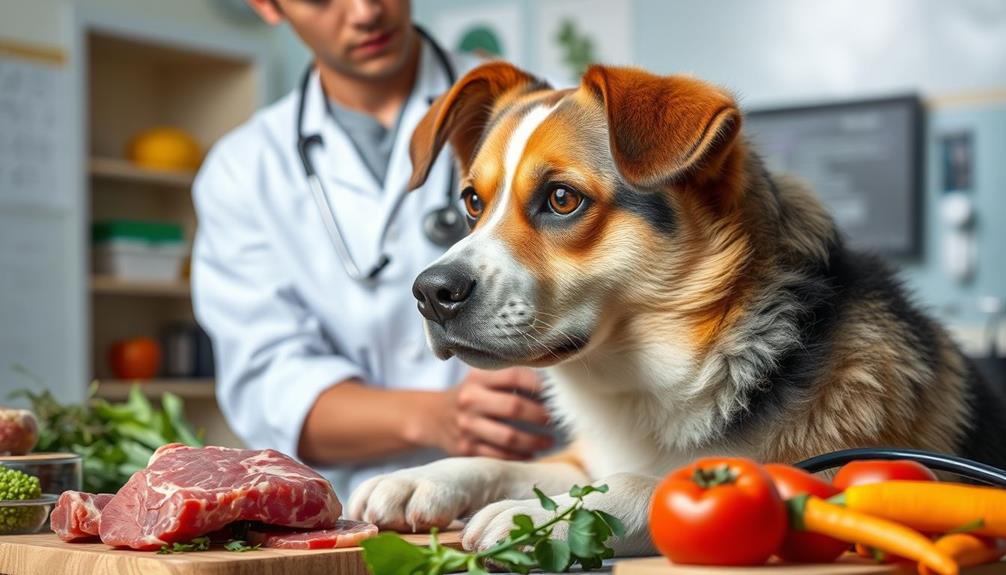
When considering a raw diet for your dog, it's essential to understand the potential risks highlighted by veterinarians. They often point out concerns about nutritional deficiencies and the risks of bacterial contamination that could affect both your pet and your family.
Understanding BPD treatment options may also provide insights into how emotional challenges can affect decision-making around pet care.
Shifting to a raw diet can also present challenges, so consulting a veterinary nutritionist is a smart move to guarantee your dog's health.
Nutritional Deficiencies Concerns
Veterinary experts frequently raise concerns about nutritional deficiencies associated with raw meat-based diets (RMBDs).
If you're considering a homemade raw diet, it's important to understand that improper balancing can lead to severe health issues for your dog. Many homemade raw diets often lack essential nutrients, which can result in significant health risks.
Here are three common nutritional deficiencies you should be aware of:
- Calcium and Phosphorus: An improper calcium-to-phosphorus ratio can lead to bone deformities, particularly in growing puppies.
- Vitamins: Many raw diets fail to provide essential vitamins that are necessary for your dog's overall health and immune function.
- Balanced Nutrient Intake: High-fat compositions may improve coat condition but don't replace the need for a well-rounded diet rich in all macro and micronutrients.
To avoid these pitfalls, consulting a veterinary nutritionist is important when contemplating raw diets.
They can guide you in formulating a balanced diet that meets your dog's nutritional needs, helping to mitigate the risks associated with deficiencies and ensuring your furry friend stays healthy and thriving.
Bacterial Contamination Risks
Choosing a raw diet for your dog might seem appealing, but it's crucial to understand the serious risks of bacterial contamination that come with it. Studies reveal nearly 25% of raw pet food samples tested positive for harmful bacteria, including Salmonella and Listeria monocytogenes. These bacterial contamination risks can lead to severe foodborne illnesses for both you and your pet.
| Bacteria | Risk to Dogs | Risk to Humans |
|---|---|---|
| Salmonella | Asymptomatic carriers | Gastrointestinal illness |
| Listeria | Can cause infections | Severe complications |
| General Risks | Contaminated raw food | Cross-contamination |
Handling raw food requires vigilance. The CDC and FDA warn that improper handling can lead to infections, particularly for vulnerable populations like children and the elderly. As a dog owner, you must implement strict food safety practices, including thorough handwashing and cleaning surfaces after contact with raw food. Being mindful of these risks helps protect everyone in your household from potential health hazards associated with raw diets.
Feeding Transition Challenges
Shifting your dog to a raw diet can be a challenging process that requires careful consideration and planning.
During the adjustment period, you might notice your dog experiencing gastrointestinal upset, like vomiting or diarrhea. To minimize these issues, it's crucial to follow a gradual introduction over 7-10 days.
Here are three key points to keep in mind:
- Veterinary Guidance: Always consult your vet before starting a raw diet, especially if your dog has a sensitive stomach or any pre-existing health conditions. They can provide tailored dietary advice.
- Monitor Response: Closely observe your dog's reactions to the new food. Any signs of distress should prompt immediate veterinary consultation to adjust the diet accordingly.
- Nutritional Balance: Ascertain the raw diet includes essential nutrients and the correct ratios of calcium to phosphorus. An improper balance can exacerbate gastrointestinal issues.
Frequently Asked Questions
Can Raw Food Upset My Dog's Stomach?
Yes, raw food can upset your dog's stomach. Abrupt dietary changes might cause vomiting or diarrhea. If your dog has health issues, introducing raw food gradually and handling it properly is essential for their well-being. Can raw food cause diarrhea in dogs? Yes, it can, especially if they are not used to it. It’s important to consult with a veterinarian before making any significant changes to your dog’s diet, as they can offer guidance on how to introduce raw food in a way that minimizes digestive upset. Additionally, always ensure that the raw food is sourced from a reputable supplier and stored and handled properly to prevent contamination. It’s also important to monitor your dog’s response to the new diet and make adjustments as needed. While raw food can have many health benefits for dogs, it’s not suitable for every pet. Some dogs may have allergies or sensitivities to certain raw foods, which could result in digestive issues. As always, closely observe your dog’s behavior and consult with a vet if you have any concerns about their reaction to the new diet. Can raw food cause diarrhea in dogs? Yes, it’s a possibility, but with proper care and attention, it can also be a nutritious and beneficial addition to your pet’s diet.
How Do I Know if My Dogs Has Gotten Sick off Raw Food?
You'll know something's wrong if your dog suddenly becomes lethargic or stops eating, contrasting their usual energy and appetite. Watch for vomiting or diarrhea, and don't hesitate to call the vet if symptoms persist.
Can Raw Dog Food Cause Problems?
Yes, raw dog food can cause problems. You might notice vomiting or diarrhea if you switch diets too quickly. Additionally, be cautious of harmful bacteria and nutritional imbalances that could impact your dog's health over time.
Can Raw Dog Food Make My Dog Sick?
Feeding your dog raw food can feel like tempting fate; it might lead to sickness. Unbalanced diets and harmful bacteria lurk within, potentially causing digestive turmoil. Always consult a vet to safeguard your furry friend's health.
Conclusion
In summary, while a raw food diet can offer benefits for your dog, it's essential to weigh the potential risks. Did you know that nearly 70% of raw dog food samples tested positive for harmful bacteria like Salmonella and E. coli? This statistic highlights the importance of handling raw food with care. Always consult your vet before making dietary changes and make certain you take necessary precautions to keep both your dog and your household safe.

